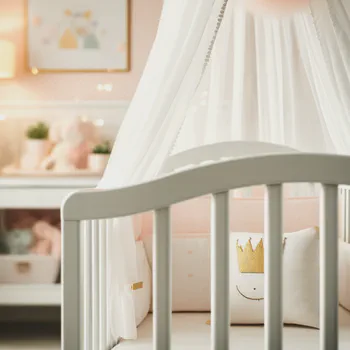
A sleep-friendly environment is crucial for ensuring your baby gets the restful sleep they need for healthy growth and development. Here’s a comprehensive guide to help you create the perfect sleep space for your little one.
Why a Sleep-Friendly Environment Matters
- Promotes Better Sleep Quality: A conducive sleep environment can significantly improve the quality and duration of your baby’s sleep. Proper conditions help your baby fall asleep faster and stay asleep longer.
- Reduces Night Wakings: A well-prepared sleep space minimizes disruptions, helping to reduce the frequency of night wakings.
- Supports Safe Sleep Practices: A safe sleep environment is essential for preventing Sudden Infant Death Syndrome (SIDS) and other sleep-related incidents.
Key Elements of a Sleep-Friendly Environment
- Comfortable Crib: Ensure your baby’s crib meets the latest safety standards. It should have a firm mattress that fits snugly without gaps. Avoid using pillows, blankets, or stuffed animals inside the crib to reduce the risk of suffocation.
- Optimal Room Temperature: The ideal room temperature for a baby’s sleep is between 68-72°F (20-22°C). Use a room thermometer to monitor and maintain the temperature.
- Proper Lighting: Babies sleep best in a dark room. Use blackout curtains to block out any outside light. A dim nightlight can be helpful for nighttime feedings and diaper changes without fully waking your baby.
- Noise Control: Reduce loud or sudden noises that could wake your baby. A white noise machine can provide a consistent and soothing sound, masking other household noises.
- Safe Sleepwear: Dress your baby in comfortable, breathable sleepwear appropriate for the room temperature. Avoid overheating by layering clothing instead of using blankets.
- Clean and Organized Space: Keep the sleep area clean and free of clutter. A tidy space can create a calming atmosphere, making it easier for your baby to relax and fall asleep.
- Air Quality: Ensure good air circulation in the room. An air purifier can help remove allergens and maintain fresh air. Avoid using strong fragrances or air fresheners that could irritate your baby’s sensitive respiratory system.
- Consistent Bedtime Routine: Establish a calming bedtime routine to signal to your baby that it’s time to sleep. This can include activities like a warm bath, gentle massage, reading a story, or playing soft music.
Tips for Success
- Personalize the Space: While maintaining safety, personalize your baby’s sleep space with calming colors and soothing decorations. Avoid overstimulating designs that might be distracting.
- Monitor and Adjust: Regularly assess the sleep environment and make necessary adjustments. As your baby grows, their needs might change, requiring tweaks to their sleep space.
- Stay Consistent: Consistency is key in helping your baby recognize their sleep environment. Try to keep the sleep space and routine the same, even during travel or changes in routine.
Conclusion
Creating a sleep-friendly environment is essential for your baby’s health and well-being. By focusing on safety, comfort, and consistency, you can help your baby develop healthy sleep habits that will benefit them for years to come. Invest time in setting up the perfect sleep space, and enjoy the peace of mind that comes with knowing your baby is resting safely and soundly.